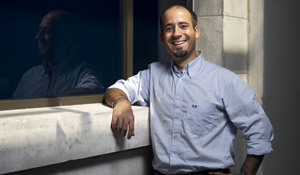He’s cooking up thin film pizzas to create cutting-edge inventions
Ever wonder how your phone connects to Wi-Fi or GPS? Inside each smartphone, there are tiny devices that vibrate like guitar strings to create electricity, says Matteo Rinaldi, professor of electrical and computer engineering. And now the technology needed to make them, which resembles a miniature pizza oven, is at Northeastern.

